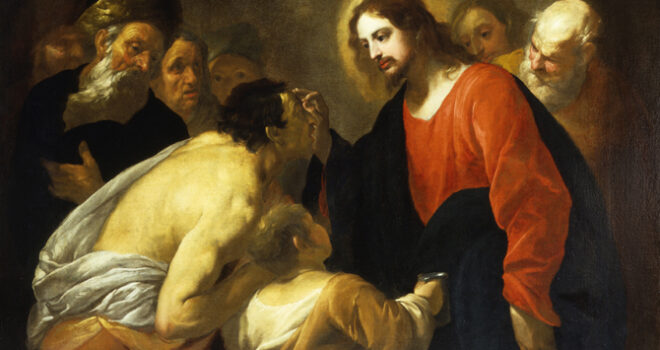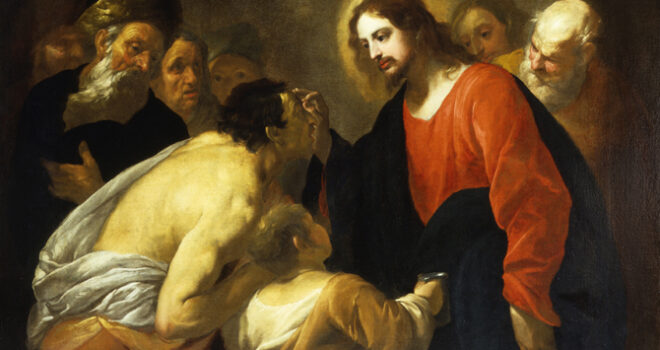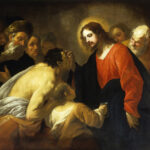Viewing and pondering sacred art, engaging in vizio divina, offers the faithful a great way to meditate more deeply on the life of Jesus Christ and the mystery of salvation. This series of articles will highlight several pieces of art related to the season of Lent, specifically the Gospel readings for each week. Each of these pieces of art allows us to reflect on the transformation to which our Lord calls us during this penitential season, and to bring the realities of these biblical episodes into our own lives.
Every three years, when the Church is in Year A of her lectionary cycle, on the Fourth Sunday of Lent, the faithful hear proclaimed the account of Jesus healing the man who was born blind, found in the ninth chapter of St. John’s Gospel. This biblical account gives us quite a bit of detail about the way that Jesus healed the man, and about the interrogation of the Pharisees in their effort to find some reason to condemn Jesus. Readers and hearers come away from this passage with a deep appreciation of Jesus as miracle-worker and healer, as well as for his method of engaging the religious establishment.
One of the most interesting artistic presentations of this event is Healing of the Man Born Blind by Orazio de Ferrari, an Italian artist from the seventeenth century. It is a painting that offers viewers the opportunities to reflect on spiritual themes that are incredibly valuable for Lent. Ultimately, this piece of art helps us to know more fully why the Church presents this biblical passage to us on Laetare Sunday.

The very first thing a viewer notices by looking at Ferrari’s painting is the contrast of dark and light. The edges of the painting are dark and hazy, while light and clarity are to be found nearer to the center of the image. It seems as though Jesus and his action are the very source of light. This detail may cause St. Paul’s exhortation from the second reading to resound in our minds: “Awake, O sleeper, and arise from the dead, and Christ will give you light” (Eph. 5:14). Lent is about moving toward the illuminated center, and away from the dark fringes. This is especially apparent on Laetare Sunday, as we celebrate the fact that we are more than halfway to the light of the Resurrection. During Lent, have I sought light and clarity, especially by prayer, fasting, and almsgiving?
As with so many other images, Jesus stands at the center of the painting as its focal point. The Messiah is clad in red, creating a stark contrast from the other figures. He is also wrapped in a black cloak, which sets him apart from the rest of the figures in the image. Perhaps the artist used these details to identify the divinity, the otherness, of Jesus Christ. Still Jesus reaches out with his human hand to touch the blind man. This gives us a remarkable opportunity to reflect on the Incarnation. True God became truly human so that he might reach out and heal our broken humanity.
Then the viewer notices the blind man. In this moment, he is hunched over, seeming quite frail. At the same time, the artist depicts him quite literally coming out of his clothes. In this passage, Jesus says, “I came into this world for judgment, so that those who do not see might see, and those who do see might become blind” (Jn. 9:39). During the Lenten season, do I recognize how I resemble this blind man? Do I need to have my sight corrected? Am I willing to shed the comforts and protections of my life in order to receive the sight I need?
We can imagine, just before the moment captured in this painting, Jesus making clay with his saliva, the clay that Jesus used to anoint the man’s eyes before his sight was restored (cf. Jn. 9:6). We can look at this small detail of the painting and realize that God wants to touch each of us, restoring our own blindness. More specifically, it allows us to recognize that God provides his grace in a sacramental way to transform us and the world. He uses the material of the earth and human touch to relate to us, to provide his healing. This ought to bring us to a deeper appreciation of and devotion to the sacraments. Do I recognize that God can use the material of this world to accomplish his purposes? Do I draw close to the Lord through the sacraments during Lent?
On the left-hand side, in the penumbra of the painting, stand four intriguing figures. One looks like he is critiquing Jesus’ action. He could definitely be one of the Pharisees who wished to discredit Jesus as the Anointed One. A couple of the other figures look confounded and astonished. These could also be Pharisees or they could represent the multitudes who were perplexed by Jesus words and actions. We can reflect on both reactions and find some points for deeper meditation. Do I take on the attitude of a Pharisee, critiquing and judging words and actions that do not conform to my conception of what is right and good? Am I simply confounded and astonished by the manner that God chooses to work in my life and in the world? Do I spend enough time talking to him about his work and his plans for me?
On the right-hand side of the image, behind Jesus, are two figures that are illuminated by slightly more light than the Pharisees. These may well represent the young man’s parents who factor into the scene. They are so afraid of the Pharisees that they simply turned the interrogation back to their son. Still, they have greater access to the light because they have witnessed the transforming miracle of their blind son receiving his sight. Like St. Thomas after the Resurrection, they have seen so now they can believe. Has the Lord shed light on me by allowing me to witness something miraculous? When I witnessed that miracle, what was my response?
Ferrari’s painting provides an incredible amount of material for reflection, even as it presents a limited number of details. The artist focuses closely on a few characters, and the action of Jesus, and he brings us to a deeper devotion to the sacraments, the material means by which Our Blessed Lord reaches out and touches us. During Lent, and in every season, the faithful should make an effort to seek Jesus’ light and healing while shedding life’s chaotic details in an effort to focus solely on Jesus’ instruction. Ferrari helps viewers to recognize that Jesus does both of these things in the sacramental life of the Church. Let’s take his lesson into the last weeks of Lent and the remainder of our year.
✠
Healing of the Man Born Blind by Orazio de Ferrari is in the public domain.












